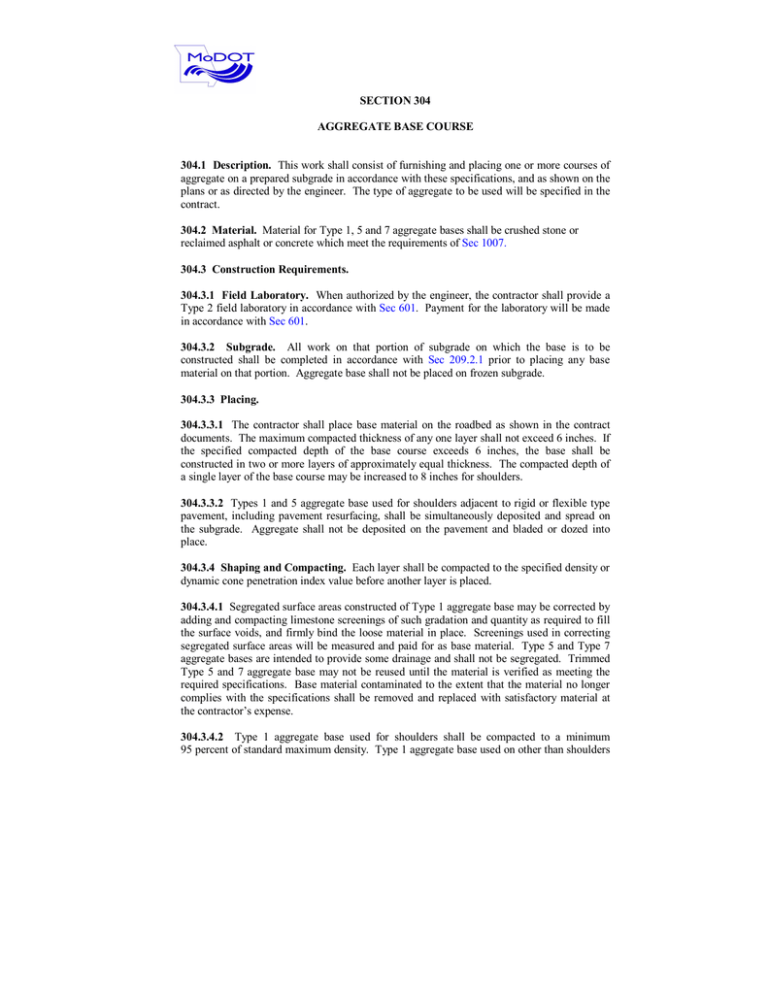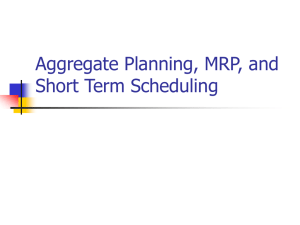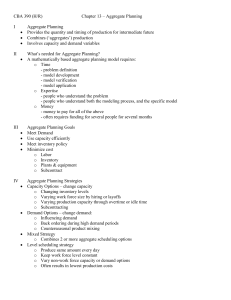SECTION 304 AGGREGATE BASE COURSE 304.1 Description
advertisement

SECTION 304 AGGREGATE BASE COURSE 304.1 Description. This work shall consist of furnishing and placing one or more courses of aggregate on a prepared subgrade in accordance with these specifications, and as shown on the plans or as directed by the engineer. The type of aggregate to be used will be specified in the contract. 304.2 Material. Material for Type 1, 5 and 7 aggregate bases shall be crushed stone or reclaimed asphalt or concrete which meet the requirements of Sec 1007. 304.3 Construction Requirements. 304.3.1 Field Laboratory. When authorized by the engineer, the contractor shall provide a Type 2 field laboratory in accordance with Sec 601. Payment for the laboratory will be made in accordance with Sec 601. 304.3.2 Subgrade. All work on that portion of subgrade on which the base is to be constructed shall be completed in accordance with Sec 209.2.1 prior to placing any base material on that portion. Aggregate base shall not be placed on frozen subgrade. 304.3.3 Placing. 304.3.3.1 The contractor shall place base material on the roadbed as shown in the contract documents. The maximum compacted thickness of any one layer shall not exceed 6 inches. If the specified compacted depth of the base course exceeds 6 inches, the base shall be constructed in two or more layers of approximately equal thickness. The compacted depth of a single layer of the base course may be increased to 8 inches for shoulders. 304.3.3.2 Types 1 and 5 aggregate base used for shoulders adjacent to rigid or flexible type pavement, including pavement resurfacing, shall be simultaneously deposited and spread on the subgrade. Aggregate shall not be deposited on the pavement and bladed or dozed into place. 304.3.4 Shaping and Compacting. Each layer shall be compacted to the specified density or dynamic cone penetration index value before another layer is placed. 304.3.4.1 Segregated surface areas constructed of Type 1 aggregate base may be corrected by adding and compacting limestone screenings of such gradation and quantity as required to fill the surface voids, and firmly bind the loose material in place. Screenings used in correcting segregated surface areas will be measured and paid for as base material. Type 5 and Type 7 aggregate bases are intended to provide some drainage and shall not be segregated. Trimmed Type 5 and 7 aggregate base may not be reused until the material is verified as meeting the required specifications. Base material contaminated to the extent that the material no longer complies with the specifications shall be removed and replaced with satisfactory material at the contractor’s expense. 304.3.4.2 Type 1 aggregate base used for shoulders shall be compacted to a minimum 95 percent of standard maximum density. Type 1 aggregate base used on other than shoulders shall be compacted to no less than standard maximum density. Type 5 aggregate base under both roadway and shoulders shall be compacted to a minimum 95 percent of standard maximum density. The Standard Compaction Test will be conducted in accordance with AASHTO T 99, Method C, replacing any material retained on the 3/4­inch sieve, as provided therein. Field density will be determined in accordance with AASHTO T 191 or AASHTO T 310, Direct Transmission, for wet density. The volume of the test hole may be reduced as necessary to accommodate available testing equipment. If nuclear density test methods are used, moisture content will be determined in accordance with AASHTO T 310, except a moisture correction factor will be determined for each aggregate in accordance with MoDOT Test Method TM 35. In lieu of the density requirements for Type 1 aggregate base used for shoulders with thicknesses less than 4 inches, the aggregate shall be compacted by a minimum of three complete coverages with a 5 ton roller. Rolling shall be continued until there is no visible evidence of further consolidation. 304.3.4.3 Type 7 aggregate base under both roadway and shoulders shall be compacted to achieve an average dynamic cone penetration index value through the base lift thickness less than or equal to 0.4 inches per blow, as determined by a standard dynamic cone penetrometer (DCP) device with a 17.6 lb hammer meeting the requirements of ASTM D6951. 304.3.4.3.1 Water shall be applied to the Type 7 base material during the mixing and spreading operations so that at the time of compaction the moisture content is not less than 5 percent of the dry weight. 304.3.4.3.2 Type 7 base shall be tested with the DCP within 24 hours of placement and final compaction. 304.3.4.4 If at any time the compacted aggregate base or subgrade becomes unstable, the contractor, at the contractor's expense, shall restore the earth subgrade and the aggregate base to the required grade, cross section and density. 304.3.5 Substitutions for Aggregate Base. If available, the contractor may substitute bituminous pavement cold millings or crushed recycled concrete in lieu of aggregate base for any temporary surface, regardless of the type or thickness of aggregate shown on the plans. If this option is exercised, the contractor shall notify the engineer at least two weeks prior to using the millings or recycled concrete, and shall identify the location from where the millings or concrete will be removed. The millings or recycled concrete shall be installed to the same dimensions shown on the plans for the aggregate base. Millings or recycled concrete shall be placed in maximum 4­inch lifts, and each lift shall be compacted by a minimum of three passes with a 10­ton roller. 304.3.6 Maintenance. The contractor shall maintain, at the contractor’s expense, the required density and surface condition of any portion of the completed aggregate base until either the prime coat or a succeeding course or pavement is placed. If a prime coat is specified in the contract, the contractor will be required to apply the prime coat on any completed portion of the aggregate base as soon as practical, or as otherwise specified. The contractor will not be permitted to apply prime if the moisture in the top 2 inches of the Type 1 or 5 aggregate base exceeds the higher of either (1) the average of the optimum moisture as determined by the Standard Compaction Test and the absorption of the plus No. 4 fraction, or (2) two­thirds of the optimum moisture as determined by the Standard Compaction Test. 304.4 Quality Control/Quality Assurance (QC/QA). 304.4.1 Quality Control. The contractor shall control operations to ensure the aggregate base, in place, meets the specified requirements for density, thickness, gradation, deleterious, and plasticity index. Tests shall be taken at random locations designated by the engineer at the following frequency: Tested Property Density Dynamic Cone Penetrometer Index Value (for Type 7 base) Thickness Test Method AASHTO T 191 or AASHTO T 310 ASTM D6951 Contractor Frequency Engineer Frequency 1 per 1000 tons, 1 per 4,000 tons, minimum of 1 per day minimum of 1 per project 1 per 1000 tons, 1 per 4,000 tons, minimum of 1 per day minimum of 1 per project Applicable 1 per 1000 tons, 1 per 4,000 tons, method meeting minimum of 1 per day minimum of 1 per engineer’s project approval Gradation and AASHTO T 11, 1 per 2000 tons, 1 per 8,000 tons, Deleterious AASHTO T 27 minimum of 1 per day b minimum of 1 per Material a and MoDOT Test project Method TM 71 Plasticity Index a AASHTO T 89 1 per 10,000 tons, 1 per 40,000 tons, and AASHTO T minimum of 1 per minimum of 1 per 90 project project a Sampled at point of delivery, prior to rolling. b When production for a week is anticipated to be 1,000 tons or less, the contractor may test the material at a frequency of 1 per 250 tons or 1 per week, whichever occurs first. 304.4.1.1 The contractor shall provide copies of the test results, including all raw data, to the engineer the next business day following testing or sampling. 304.4.1.2 The contractor or the contractor’s representative shall also determine the standard maximum dry density and the optimum moisture content for Type 1 and 5 base material and the dry weight for Type 7 base material and supply all test data to the engineer. 304.4.1.3 When density or DCP index value tests are less than specified or when thickness measurements indicate the thickness is deficient by more than 1/2 inch from the plan thickness, additional measurements will be taken at 100­foot intervals parallel to centerline ahead and behind the tested location until the extent of the deficiency has been determined. Each measurement will be assumed as representative of the base thickness for a distance extending one­half the distance to the next measurement, measured along centerline, or in the case of a beginning or ending measurement, the distance will extend to the end of the base section. Any deficient areas shall be corrected by reworking or adding material within the limits of the deficiency. 304.4.1.4 When two consecutive tests for gradation, deleterious material, or plasticity index do not meet the specification limits, the material shall be removed beginning at the point where the first test was conducted. 304.4.1.5 The contractor shall retain the untested portion of the plasticity index, gradation and deleterious sample for the engineer’s use. 304.4.2 Quality Assurance. The contractor’s QC test results and the engineer’s QA test results shall meet the specifications and the following. For Type 1 and 5 base the contractor’s compaction standard tests shall compare within 3.0 pounds of the maximum density of the MoDOT determined compaction standard. For Type 7 base the contractor’s average DCP penetration index shall compare within 0.1 inches per blow of the MoDOT determined average penetration index. For retained samples, the contractor’s test results and the engineer’s test results shall compare within the following limits: (a) The total deleterious material shall be within 2.0 percentage points. (b) The plasticity index shall be within 2. (c) The gradation test results shall compare within the following limits: Sieve 1 1/2­inch 1­inch 3/4­inch 1/2­inch No. 4 No. 8 No. 10 No. 30 No. 40 No. 100 No. 200 Tolerance (%) ± 5.0 ± 5.0 ± 5.0 ± 5.0 ± 4.0 ± 4.0 ± 3.0 ± 3.0 ± 2.0 ± 2.0 ± 1.0 304.5 Method of Measurement. Final measurement of the completed aggregate base course will not be made except for authorized changes during construction, or where appreciable errors are found in the contract quantity. Measurement will include aggregate course placed under curb and gutter. Where required, measurement of aggregate base course, complete in place, will be made to the nearest square yard . Where the aggregate base course extends to the inslope of the shoulder, the pay limit of the aggregate base course will be measured from the mid­point of the sloped portion. The revision or correction will be computed and added to or deducted from the contract quantity. 304.6 Basis of Payment. The accepted quantities of aggregate base course of the thickness and type specified will be paid for at the contract unit price for each of the pay items included in the contract. Payment will be considered full compensation for water used in performing this work. When bituminous pavement cold millings or recycled crushed concrete are substituted for aggregate base, payment will be made for the aggregate base quantity provided in the plans, regardless of whether millings, recycled crushed concrete or the aggregate base is used. Payment will be considered full compensation for hauling of millings, cold milling operations, and all other material or labor necessary to substitute bituminous pavement millings for aggregate base.






